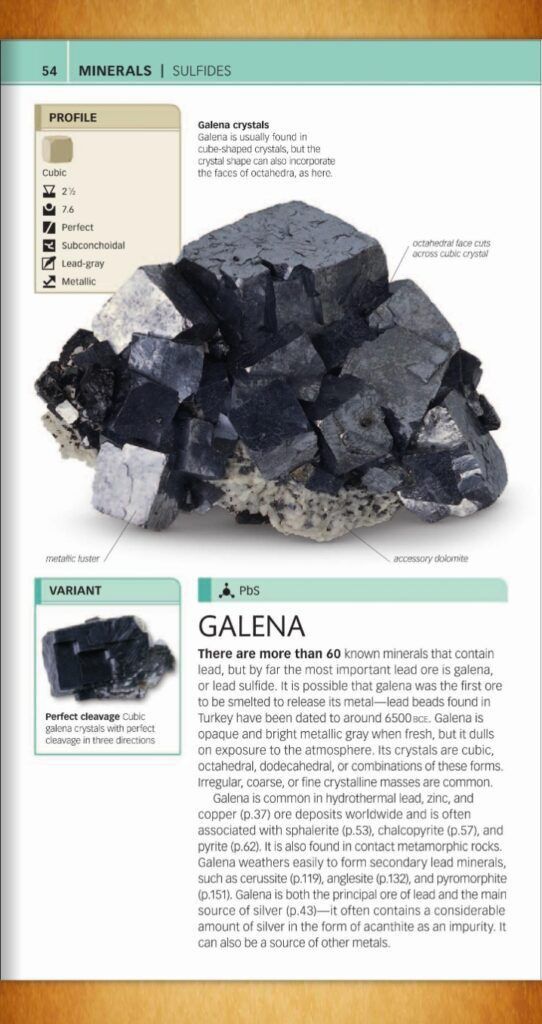Galena, with its distinctive metallic luster and cubic crystal structure, is one of the most significant minerals in the mining industry. As the primary ore of lead and a notable source of silver, it plays a vital role in both economic geology and industrial applications. This article provides a comprehensive overview of galena’s formation, properties, and global importance, catering to students and professionals alike.
What is Galena?
Galena is a lead sulfide mineral (PbS) and a member of the sulfide group. It is easily recognized by its shiny, silver-gray appearance, high density, and perfect cubic cleavage. Often occurring in well-formed cubes or octahedrons, galena is both an industrially valuable mineral and a classic subject for geological studies.

How is Galena Formed?
Galena forms primarily through hydrothermal and sedimentary processes, with occasional occurrences in metamorphic environments.
1. Hydrothermal Formation
Galena is commonly deposited in hydrothermal veins, where mineral-rich hot fluids circulate through fractures in rocks.
These fluids, carrying dissolved lead (Pb) and sulfur (S), crystallize into galena as they cool or encounter chemical changes.
2. Sedimentary Formation
In sedimentary rocks like limestone and dolostone, galena forms at lower temperatures through chemical reactions between lead-bearing solutions and sulfur sources such as organic material.
3. Metamorphic Formation
Occasionally, galena forms during the metamorphism of lead-bearing sedimentary rocks subjected to high pressure and temperature.
Physical and Chemical Properties
Galena is known for its striking metallic appearance and high density. These physical characteristics, combined with its soft nature, make it easy to identify.
Color: Lead gray to silver.
Luster: Metallic and highly reflective.
Hardness: 2.5–2.75 on the Mohs scale.
Cleavage: Perfect cubic, breaking into shiny, reflective blocks.
Specific Gravity: Very high (7.4–7.6), owing to its lead content.
Chemical Composition: Lead sulfide (PbS).
Where is Galena Found?
Galena is widely distributed across the globe, occurring in diverse geological settings such as hydrothermal veins, sedimentary deposits, and skarn zones.
1. Hydrothermal Veins
These deposits form when hot fluids deposit galena in fractures and cavities.
Example: The Lead Belt in Missouri, USA, and Broken Hill, Australia.
2. Sedimentary Rocks
Galena commonly forms in limestone and dolostone through low-temperature processes.
Example: Mississippi Valley-Type (MVT) deposits in the USA.
3. Skarn Deposits
Galena forms in zones where igneous rocks intrude into carbonate-rich sedimentary rocks.
Example: Deposits in Tibet and Central Asia.
4. Notable Global Locations
USA: Missouri, Idaho, and Colorado.
Australia: Broken Hill and Mount Isa.
Germany: Freiberg region.
Pakistan: Chagai District (Balochistan) and Khyber Pakhtunkhwa.
Peru: Known for silver-rich galena deposits.
Economic Importance of Galena
1. Lead Production
Galena is the primary source of lead, a metal essential for:
Battery Manufacturing: Particularly lead-acid batteries for vehicles.
Radiation Shielding: Lead’s high density makes it ideal for protecting against X-rays and nuclear radiation.
Alloys and Soldering: Widely used in various industries.
2. Silver Production
Many galena deposits contain significant amounts of silver as a byproduct, making it a valuable source of this precious metal.
3. Geological Indicator
Galena often occurs alongside other valuable minerals such as sphalerite (zinc sulfide) and chalcopyrite (copper iron sulfide), serving as a guide for mineral exploration.
Environmental Concerns
The mining and processing of galena come with environmental and health challenges. Lead is a toxic heavy metal, and improper handling or disposal of galena ores can lead to contamination of soil, water, and air. Sustainable mining practices, waste management, and lead recycling are critical in minimizing these risks.
Applications in Geology and Education
Galena is not only valuable as an industrial mineral but also as an educational tool.
Crystallography: Its cubic structure makes it a classic example for studying mineral crystallography.
Geochemical Studies: The lead isotopes in galena are used to date geological events and analyze ore genesis.
Educational Specimens: Galena’s distinct properties make it a staple in geology labs and teaching kits.
Interesting Facts About Galena
1. The name “galena” derives from the Latin word for lead ore.
2. Galena has been used since ancient times to extract lead and even as a cosmetic (kohl) in ancient Egypt.
3. Its high density made it historically useful as ballast in ships and counterweights in machinery.
Conclusion
Galena remains a cornerstone mineral in mining, geology, and industrial applications. Its role as the primary source of lead and a significant producer of silver highlights its economic importance. Whether you’re a student exploring its properties or a professional involved in mineral exploration, understanding galena offers insights into mineral formation, resource extraction, and environmental stewardship.
From its stunning cubic crystals to its role in modern industries, galena continues to captivate and serve humanity in remarkable ways.
Leave a comment